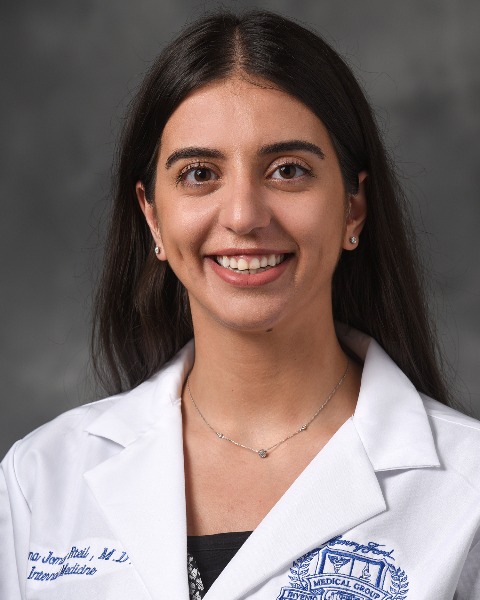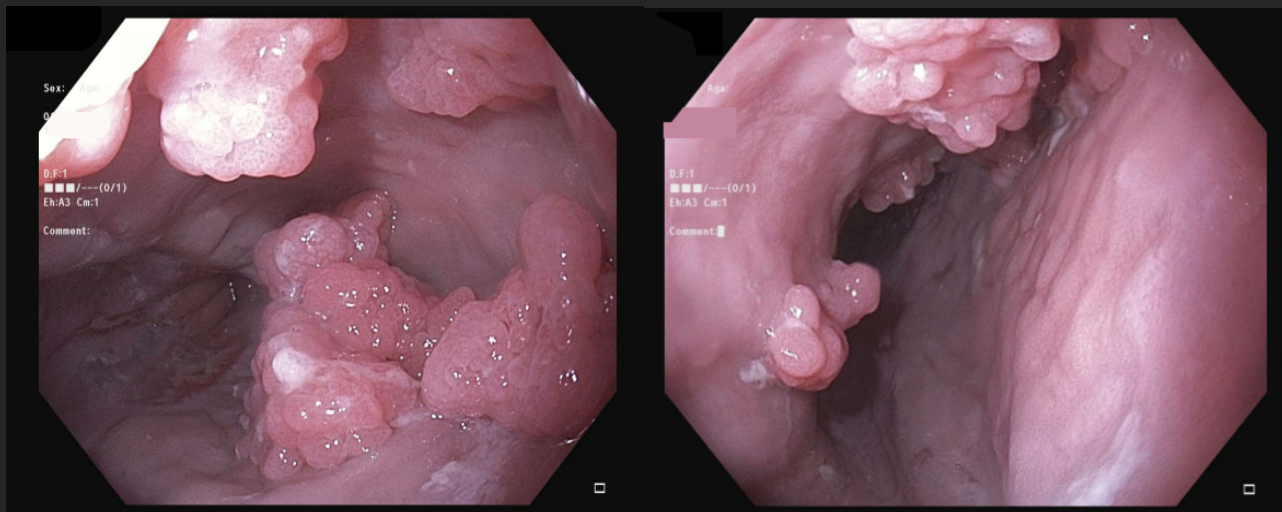Monday Poster Session
Category: Esophagus
P2895 - Polyp by Polyp: Navigating the Management of Rare Esophageal Papillomatosis
Monday, October 27, 2025
10:30 AM - 4:00 PM PDT
Location: Exhibit Hall

Diana Jomaa, MD
Henry Ford Health
Detroit, MI
Presenting Author(s)
Renieh M. Nabaty, MD, Diana Jomaa-Rteil, MD, Robert Pompa, MD
Henry Ford Health, Detroit, MI
Introduction: An esophageal papilloma (EP) is a solitary sessile lesion covered in benign squamous epithelium. In conjunction, esophageal papillomatosis (EPS) is the presence of multiple esophageal papillomas and is an exceedingly rare diagnosis, described in case reports- with approximately 53 documented cases to date. The etiology of EPS is not well defined; it has been associated with chronic mucosal irritation, human papillomavirus (HPV) infection, or genetic mutations. EPS may present with dysphagia, refractory GERD, or epigastric abdominal pain. Less than a quarter of reported EPS cases were associated with esophageal cancer. There is no consensus on the treatment of EPS, however, trialed therapies have included endoscopic interventions like cryotherapy, ablation, and laser therapy. We present a rare case of EPS in a patient with known GERD, managed with serial polypectomies.
Case Description/
Methods: A 55-year-old male with a history of tobacco use presented with intermittent acid reflux and dysphagia. Initial endoscopy showed multiple, conglomerate esophageal polyps in the middle and lower esophagus, 50% of polyp burden was removed via cold snare polypectomy. Pathology was consistent with squamous papillomas. Eight months later, repeat endoscopy with polypectomy demonstrated recurrence of multiple polyps in the mid and distal esophagus consistent with prior endoscopy, and pathology again revealed squamous papillomas without dysplasia. The patient was due for follow-up endoscopy, however, was lost to follow-up and re-presented four years later for surveillance. Endoscopy at that time demonstrated large, lobulated polyps, the largest about 3 cm in size (Figure 1). Distal polyps were resected. Pathology re-demonstrated squamous papillomas with focal acute inflammation and without dysplasia. The patient continued to undergo surveillance endoscopies at regular intervals.
Discussion: EPS is a rare condition, without standardized treatment guidelines. Given the potential, albeit rare, risk for malignant transformation, patients with EPS may benefit from regular surveillance endoscopies and evaluation for potential etiologies such as HPV infection. The rarity of EPS limits the availability of large-scale studies; thus providers may rely on case reports for guidance. This case adds to the limited literature on EPS, providing insights into disease progression, therapeutic options, and the importance of consistent follow-up, emphasizing the need of awareness and ongoing research on EPS.

Figure: Figure 1: Multiple esophageal polyps as seen on upper endoscopy.
Disclosures:
Renieh Nabaty indicated no relevant financial relationships.
Diana Jomaa-Rteil indicated no relevant financial relationships.
Robert Pompa indicated no relevant financial relationships.
Renieh M. Nabaty, MD, Diana Jomaa-Rteil, MD, Robert Pompa, MD. P2895 - Polyp by Polyp: Navigating the Management of Rare Esophageal Papillomatosis, ACG 2025 Annual Scientific Meeting Abstracts. Phoenix, AZ: American College of Gastroenterology.
Henry Ford Health, Detroit, MI
Introduction: An esophageal papilloma (EP) is a solitary sessile lesion covered in benign squamous epithelium. In conjunction, esophageal papillomatosis (EPS) is the presence of multiple esophageal papillomas and is an exceedingly rare diagnosis, described in case reports- with approximately 53 documented cases to date. The etiology of EPS is not well defined; it has been associated with chronic mucosal irritation, human papillomavirus (HPV) infection, or genetic mutations. EPS may present with dysphagia, refractory GERD, or epigastric abdominal pain. Less than a quarter of reported EPS cases were associated with esophageal cancer. There is no consensus on the treatment of EPS, however, trialed therapies have included endoscopic interventions like cryotherapy, ablation, and laser therapy. We present a rare case of EPS in a patient with known GERD, managed with serial polypectomies.
Case Description/
Methods: A 55-year-old male with a history of tobacco use presented with intermittent acid reflux and dysphagia. Initial endoscopy showed multiple, conglomerate esophageal polyps in the middle and lower esophagus, 50% of polyp burden was removed via cold snare polypectomy. Pathology was consistent with squamous papillomas. Eight months later, repeat endoscopy with polypectomy demonstrated recurrence of multiple polyps in the mid and distal esophagus consistent with prior endoscopy, and pathology again revealed squamous papillomas without dysplasia. The patient was due for follow-up endoscopy, however, was lost to follow-up and re-presented four years later for surveillance. Endoscopy at that time demonstrated large, lobulated polyps, the largest about 3 cm in size (Figure 1). Distal polyps were resected. Pathology re-demonstrated squamous papillomas with focal acute inflammation and without dysplasia. The patient continued to undergo surveillance endoscopies at regular intervals.
Discussion: EPS is a rare condition, without standardized treatment guidelines. Given the potential, albeit rare, risk for malignant transformation, patients with EPS may benefit from regular surveillance endoscopies and evaluation for potential etiologies such as HPV infection. The rarity of EPS limits the availability of large-scale studies; thus providers may rely on case reports for guidance. This case adds to the limited literature on EPS, providing insights into disease progression, therapeutic options, and the importance of consistent follow-up, emphasizing the need of awareness and ongoing research on EPS.

Figure: Figure 1: Multiple esophageal polyps as seen on upper endoscopy.
Disclosures:
Renieh Nabaty indicated no relevant financial relationships.
Diana Jomaa-Rteil indicated no relevant financial relationships.
Robert Pompa indicated no relevant financial relationships.
Renieh M. Nabaty, MD, Diana Jomaa-Rteil, MD, Robert Pompa, MD. P2895 - Polyp by Polyp: Navigating the Management of Rare Esophageal Papillomatosis, ACG 2025 Annual Scientific Meeting Abstracts. Phoenix, AZ: American College of Gastroenterology.
